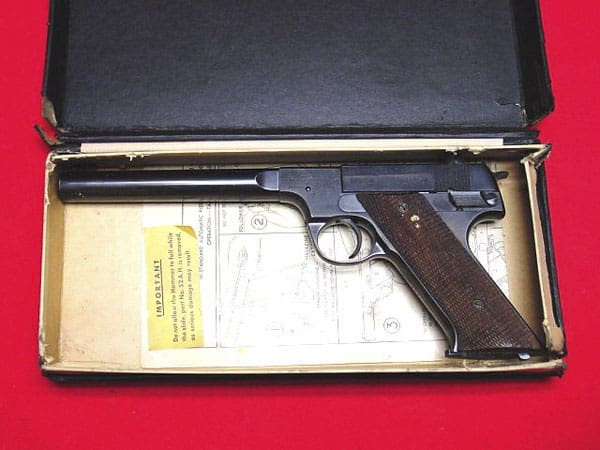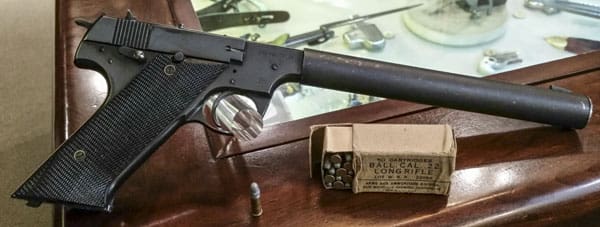
Many of James Bond’s gadgets are pure fantasy, but some of them are rooted in aspects of reality. Some real life examples of similar objects were used during World War II by actual spies.
The Office of Strategic Services (OSS) was the direct forerunner of today’s Central Intelligence Agency. William J. Donovan (nicknamed “Wild Bill”) headed up the organization at the request of President Franklin D. Roosevelt in 1942. When it began with 600 staffers and a $10 million budget, the purpose of the OSS was to conduct clandestine missions, act as spies, gather intelligence, and perform sabotage, among other things. By war’s end, the OSS had approximately 13,000 staffers and a budget of $43 million.
When operating in places you’re not supposed to be, stealth is of the utmost importance. This includes the guns that are used. A desire for a firearm that could be used in close quarters with very little sound when fired emerged.

Enter the High Standard HDM. Based on High Standard’s HD target pistol, this .22 caliber handgun had an ace up its sleeve: it was integrally suppressed.
In an effort to gain approval from the highest seat of power – the President – “Wild Bill” Donovan arranged for a demonstration of the gun in front of FDR. Donovan strolled into the Oval Office while FDR was busy working with his secretary, placed a sand trap on the floor, and fired ten rounds as fast as he could. He then walked over to FDR, handed him the pistol, and explained what he had just done while the President was otherwise occupied.
FDR was impressed and kept the gun – more on that later.
A total of 2,600 HDMs were manufactured. The barrel itself has a total of 48 ports (12 on each side) which is enclosed in the suppressor shroud. The suppressor itself contained fine brass mesh (designed to be replaced every 200-250 rounds) and baffles. Because .22LR ammo is subsonic, this unique suppressor combination created a gun fit for a spy.
Most cheap .22LR bullets are plain lead. This presented a problem in times of war because lead projectiles were forbidden by the Hague Convention. As a result, full-metal jacketed .22LR was created for use in these guns. (I’m sure it provided little comfort to those killed by the HDM to know that the OSS made sure they were only eliminating threats using ammunition approved by the Hague Convention.)
FDR was so impressed by the little gun that he even put it on display at his Hyde Park home in New York, much to the dismay of Donovan. “Wild Bill” encountered similar issues with the HDM that had been given to Admiral Nimitz, since photos of the admiral and some kids shooting the HDM showed up in the local paper in 1944. That’s not exactly the kind of attention you want to bring to a classified firearm!
While the HDM was an influential little gun, it’s a firearm that is relatively forgotten by most people. Since it was such a big secret when in service, it was easy to overlook after WWII.
The HDM at Hyde Park was soon removed from display because it was an NFA item that had not gone through the proper channels. Where it eventually ended up is anybody’s guess. In 1986, the CIA contacted both the National Park Service and the National Archives to inquire as to the whereabouts of FDR’s HDM pistol. What, if any, reply they received is unknown. What is known, though, is that both the NPS and the NA have no knowledge of the gun in their collections today.
Of the 2,600 made, the exact number still in existence is unknown. Some examples are likely still overseas. Some are in private collections; others are in museums, such as Admiral Nimitz’s example, which can be seen at the Museum of the Pacific War. A cutaway version is on display at the NRA National Firearms Museum. The ATF claims that they are not set up to provide the specific number of any registered model of gun. Because of this, we can only hazard a guess. The estimate is that only 10 are known to be legally registered and possessed in the United States.
As such, if you come across a High Standard HDM and cannot locate the registration papers, you’d be wise to channel your inner-OSS operative and ensure that both you and the gun slip back into the shadows.
(Firearm courtesy of NRA Museums)
Logan Metesh is a firearms historian and consultant who runs High Caliber History LLC. Click here for a free 3-page download with tips about caring for your antique and collectible firearms.



What gun article? I didn’t read any gun article. No idea what you’re talking about.
“whistles”….
yup.
After working this long in IT/computer support, I can assure you I can play stupid for eternity, having been educated by my users.
I did not read this, no reason to self destruct.
” The suppressor itself contained fine brass mesh (designed to be replaced every 200-250 rounds) and baffles.”
As I understand it, the end user is prohibited from replacing ‘consumables’ on suppressors.
Like that $75 oil-filter thread adapter suppressor, once ‘shot out’ it must be returned to company that made it.
How do they get around this restriction on this?
“lead projectiles were forbidden by the Geneva Convention”
The Hague Convention.
Cool gun, but that pic is a regular HD, not the suppressed HDM.
Tom
Tom, FWIW the Wikipedia page for the High Standard HDM features this exact photo.
Other web sites have the correct picture showing the wider barrel needed to accommodate the integral suppressor.
Yep, because I have an H-D Military. When I saw the Wikipedia pic a few weeks ago, I suddenly had a momentary concern, if you will, that I had a potentially unregistered NFA weapon. Which would have been a problem to say the least.
Fortunately, further research proved my concern to be unfounded, but it just goes to show that you can’t take anything at face value, no matter how much sense it might seem to make.
Tom
A photo of an actual HDM has been added to the body of the post.
As an aside, if people are looking for high-quality .22 target pistols at prices more reasonable than a S&W Model 41, you can do much worse than looking at some of the old High Standard target pistols.
I think they used those in Spymaker: The Secret Life of Ian Fleming, when the British raided a German facility in Norway. I remember Fleming shooting a German soldier with a very similar looking mouse fart gun.
(I haven’t seen the movie in almost 30 years, so I could be off on some details).
I would rather have the welrod. sure its not semi auto, but you’re more likely gonna kill the person
trouble is you will properly own neither
I had a High Standard that looked a lot like that , without suppressor of course, that was chambered in .380 acp. Big gun for a small caliber.
My local gun store has an internally suppressed semi auto 22lr on display/for sale. I think it’s an old ruger?
man I would love an internally suppressed 22lr.
In the middle 60’s, I served in the Army as a small arms repairman in the 3rd Division. HQ3ID had one of these in inventory, as well as several M1911 unmodified pistols. I was assigned to the inspection team for a while, and handled the High Standard some. The one at. HQ had the inner screen baffles missing.
Hague Declaration of 1899 does not prohibit lead bullets, only “bullets which expand or flatten easily in the human body”. British .38/200 cartridge was loaded with a lead bullet for many years, as were other military revolver cartridges.
To start with, the pre-War target model was the HD, the post-War civilian model was the HD Military, and the subject of this article was designated as the HD-USA. A little more basic research before writing the article would have given it a little more gravitas… writing a whole article calling a gun by the wrong name is not very impressive. I found this article with a Google search, but it was pretty uninformative.
Comments are closed.